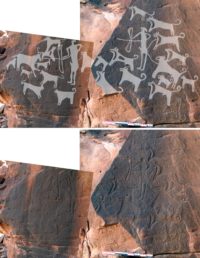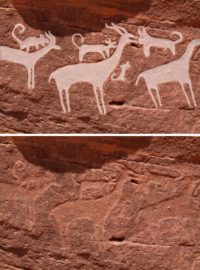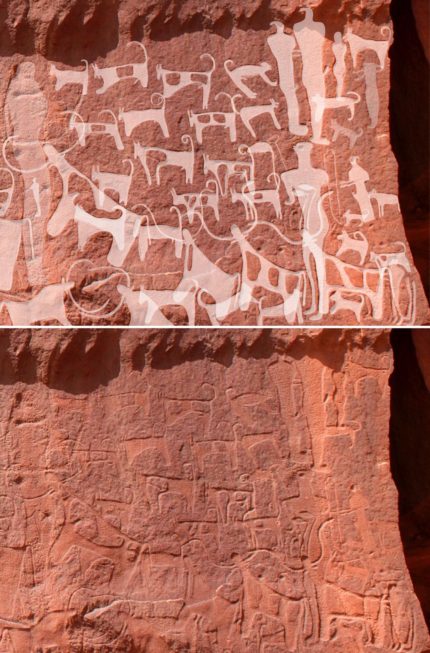 Intricately etched rock panels in the Saudi desert include some of the earliest known depictions of dogs and humans hunting together and of canines being handled by people with leashes. A recent study of some 1,400 rock art panels at the sites of Shuwaymis and Jubbah in northwestern Saudi Arabia found 147 scenes of packs of dogs helping people take down prey like equids (likely African asses), lions, ibex, gazelles and leopards. The canines did front lines duty, assault the prey with overwhelming forces to weaken them before the humans came in with bows and arrows to deliver the killing blows. In one scene in which 21 dogs surround an equid mother and her young, two of the dogs have a thick line carved from their necks to their humans’ hip, the earliest known evidence of this familiar link in prehistory.
Intricately etched rock panels in the Saudi desert include some of the earliest known depictions of dogs and humans hunting together and of canines being handled by people with leashes. A recent study of some 1,400 rock art panels at the sites of Shuwaymis and Jubbah in northwestern Saudi Arabia found 147 scenes of packs of dogs helping people take down prey like equids (likely African asses), lions, ibex, gazelles and leopards. The canines did front lines duty, assault the prey with overwhelming forces to weaken them before the humans came in with bows and arrows to deliver the killing blows. In one scene in which 21 dogs surround an equid mother and her young, two of the dogs have a thick line carved from their necks to their humans’ hip, the earliest known evidence of this familiar link in prehistory.
 The dogs are morphologically similar to modern-day Canaan dogs with pointed ears and curly tails, but there’s no way of knowing if they are an ancestor of the breed, or even if they were imported to the area of descendants of native tamed wolves. The fact that some of the dogs were leashed suggests there were already being utilized and trained for different jobs on the hunt. The exact date of the rock art is also unclear. Archaeologists believe they date to the Holocene, about 8,000-9,000 years ago, but there was no material at the rock art sites that could yield precision dating.
The dogs are morphologically similar to modern-day Canaan dogs with pointed ears and curly tails, but there’s no way of knowing if they are an ancestor of the breed, or even if they were imported to the area of descendants of native tamed wolves. The fact that some of the dogs were leashed suggests there were already being utilized and trained for different jobs on the hunt. The exact date of the rock art is also unclear. Archaeologists believe they date to the Holocene, about 8,000-9,000 years ago, but there was no material at the rock art sites that could yield precision dating.
“This is the first imagery of a dog with a leash,” said Michael Petraglia, an archaeologist from the Max Planck Institute for the Science of Human History, in Germany, and an author of the study, which appeared in the Journal of Anthropological Archaeology and was first reported by Science. He said that because of where the lines were on the dog and human’s anatomy, they most likely represented actual leashes and were not mere symbolic lines.
Dr. Petraglia added that the rock art most likely dated to the early Holocene period, which began around when the Paleolithic ice age closed. But he acknowledged that the team was unable to date it directly because the etchings left little indication for when they were carved. Instead the team correlated the rock art with nearby archaeological sites that they had dated.
The team also found that the dog images were carved beneath images of cattle, which they said indicated that the dog images came earlier. They said earlier evidence had suggested these particular ancient humans had domesticated dogs before they began keeping cattle. They added that the transition from being hunter-gatherers to herding most likely occurred between 6,800 B.C. and 6,200 B.C., which they used to hypothesize that the rock art featuring dogs appeared before humans began herding.
“We can now say about 9,000 years ago people already controlled their dogs and had them on leashes and used them for really complex hunting strategies,” said Maria Guagnin, an archaeologist from the Max Planck Institute for the Science of Human History and lead author.
The dating is tenuous, however. Until they find direct evidence of the age of the rock art, they can’t confirm with certainty that this is the earliest leashed dog depiction or what it says about the development of human-canine cooperation before the Neolithic. The study has been published in the Journal of Anthropological Archaeology and can be read free of charge online.

Those also seem to be among the ‘earliest known depictions’ of cats and humans hunting .. each other :confused:
Indeed, it seems as if we are dealing here with herders and occasional hunters. With dogs, it becomes evident, you hunt, herd and you cook.
Dating rock art is always so difficult. You suggested the transition from being hunter-gatherers to herding occurred between 6,800-6,200 BC, so the rock art featuring dogs appeared before humans began herding.
Likewise in Australia’s Northern Territory, the simplest of figures eg shadows of hands & stick figures of kangaroos and crocodiles, may be dated back to 8,000 years ago.
Thanks for a very useful link
Hels
https://melbourneblogger.blogspot.com.au/2017/11/australian-aboriginal-rock-art-in.html
I’ve often wondered if early humans learned to hunt by first watching, following and scavenging on leftovers from packs of dogs out on the hunt?
Humans in many hunter-gather societies and dogs hunt a lot alike. Chase in a group switching lead runners, exhaust, wait for it to reach near-collapse, move in, and kill. It’s been a very successful strategy for both species for a very long time.
It makes me wonder at times who domesticated who?
Human/dog hunting is very, very old. Today we are still intertwined. We all know who is in charge. Now if you will excuse me, my Poodle mistress says I am late with her supper, and that I must prep the bed so she can sleep on my pillows.
Cave canem!